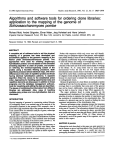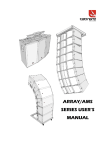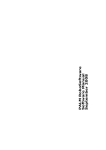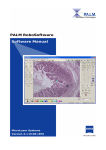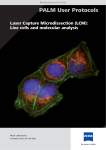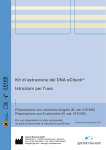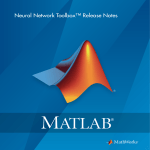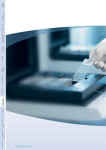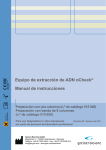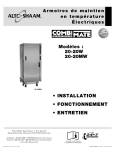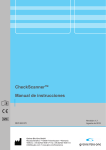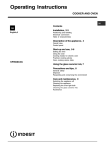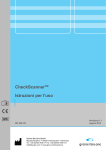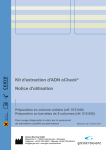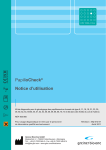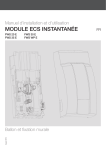Download CarnoCheck® Instructions For Use - Greiner Bio
Transcript
CarnoCheck® Instructions For Use 30 DANGER Food DNA-Chip 4 °C 8 °C Parallel qualitative detection of 8 animal species constituents in meat food products REF 462 030 For professional users only Greiner Bio-One GmbH Maybachstr. 2 • 72636 Frickenhausen • Germany Phone: +49 (0) 7022 948-0 • Fax +49 (0) 7022 948-514 [email protected] • www.gbo.com/bioscience Revision: BQ-020-02 May 2015 GLOSSARY OF SYMBOLS ! en Store in the dark Use by Consult Instructions For Use Catalog Number Manufacturer Temperature limitation Contents sufficient for <n> tests Warning Danger de Im Dunkeln lagern Mindestens haltbar bis Vor Gebrauch Anweisung lesen Katalognummer Hersteller Temperaturbegrenzung Inhalt ausreichend für <n> Tests Achtung fr À stocker à l‘abri de la lumière Date limite de conservation jusqu’au Lire les instructions avant utilisation Numéro de référence Fabricant Limite de température Contenu suffisant pour <n> tests es Conservar en un lugar oscuro A utilizar preferiblemente antes de Antes de usar, lea las instrucciones Número de catálogo Fabricante Limitación de temperatura it Conservare al buio Da utilizzare entro e non oltre Leggere le istruzioni prima dell’uso Numero catalogo Produttore pt Conservar num local escuro A utilizar preferívelmente antes de Antes de usar, leia as instruções Número de catálogo nl Donker bewaren Tenminste houdbaar tot Gebruiksaanwijzing lezen Catalogusnummer da Opbevares mørkt Anvendes senest Læs brugsanvisningen Katalognummer Producent sv Förvaras mörkt. Sista förbrukningsdag Läs bruksanvisningen före användning Katalognummer Tillverkare pl Przechowywa ć w ciemności Termin zydatności Przed Numer użyciem kataloprzeczytać gowy qualitative detection instrukcję Producent CarnoCheck code Note Gefahr Chargenbezeichnung Wichtiger Hinweis Attention Danger Code du lot Note importante Contenido suficiente para <n> ensayos Atención Peligro Código de lote Nota importante Limitazione temperatura Contenuto sufficiente per test <n> Attenzione Pericolo Codice del lotto Nota importante Fabricante Limitação de temperatura Conteúdo suficiente para <n> ensaios Atençao Perigo Código do lote Aviso importante Fabrikant Temperatuurbeperking Voldoende inhoud voor <n> tests Waarschuwing Gevaar Lot nummer Belangrijke opmerking Temperaturbegraensær Indeholder nok til <n> test Advarsel Fare Lotnummer Vigtig henvisning Temperatur-begränsning Innehållet räcker till <n> tester Varning Fara Lot nummer Viktigt meddelande NIEBEZPIECZ EŃSTWO Kod partii Ważne Instructions For Use Parallel no ® Oppbevaholdbar REF 462 030til res mørkt For Les katalogbruksannummer visning før brukusers only professional el Αποθηκεύεται στα σκοτεινά το λιγότερο διατηρείται tr Karanlık yerde saklayınız Son kullanma tarihi: πριν την χρήση διαβάστε τις οδηγίες Αριθμός Καταλόγου of 8 OgraniZawartość Uwaga czenie wystarcza temperana <n> animaltury speciestestów constituents in meat food products produsent temperaturbegrensning Innhold tilstrekkelig for <n> tester Obs Fare batch nr. Παραγωγός περιoριoμός θερμοκραο ίας Περιεχόμενο αροκετό για <n> τεοτ ΠΡΟΣΟΧΉ ΚΊΝΔΥΝΟΣ Revision: BQ-020-02 κωδικός Σημαντική παρτίδας υπόδειξη May 2015 Sıcaklık sınırlaması İçeriği <n> test için yeterlidir Dikkat Tehlikeli Partikodu Kullanma- Katalog Üretici dan önce numarası firma talimatı okuyun Greiner Bio-One GmbH Maybachstr. 2 • 72636 Frickenhausen • Germany Phone: +49 (0) 7022 948-0 • Fax +49 (0) 7022 948-514 [email protected] • www.gbo.com/bioscience CarnoCheck® - Instructions For Use Revision: BQ-020-02 / May 2015 F oBatch o d D N AImportant -Chip Viktig merknad Önemli Not 2 TABLE OF CONTENTS 1. KIT CONTENTS ............................................................................................................. 5 F o o d D N A - C h i p6 2. CONSUMABLES, EQUIPMENT AND HARDWARE REQUIRED ................................. 3. SHIPMENT AND STORAGE.......................................................................................... 8 4. SAFETY INSTRUCTIONS ............................................................................................. 8 5. WASTE DISPOSAL ..................................................................................................... 10 6. INTRODUCTION ...........................................................................................................11 6.1 Intended use ................................................................................................................................... 12 6.2 Assay principle............................................................................................................................... 13 6.3 Design of the CarnoCheck® DNA chip .......................................................................................... 15 6.3.1 CarnoCheck® chip layout ..................................................................................................... 15 6.3.2 On-chip controls ................................................................................................................... 16 7. INSTRUCTIONS FOR THE CARNOCHECK® WORKFLOW ...................................... 17 7.1 General instructions ...................................................................................................................... 17 7.2 Room separation ............................................................................................................................ 17 7.3 Warnings and precautions ............................................................................................................ 18 7.3.1 Contamination prevention .................................................................................................... 18 ® 7.3.2 Instruction for handling DNA chips ....................................................................................... 18 7.3.3 General precautions............................................................................................................. 18 7.3.4 Working safely ..................................................................................................................... 19 CarnoCheck Instructions For Use 8. CARNOCHECK® PROCEDURE .................................................................................. 20 8.1 Sample collection, homogenisation and DNA extraction........................................................... 20 8.1.1 Sample collection ................................................................................................................. 20 8.1.2 Homogenisation ................................................................................................................... 20 8.1.3 DNA extraction ..................................................................................................................... 22 8.2 Polymerase chain reaction (PCR)................................................................................................. 23 8.2.1 Thermal cycler set-up .......................................................................................................... 23 Parallel qualitative detection of 8 animal species constituents in meat food products 8.2.2 PCR reaction set-up............................................................................................................. 24 8.3 Hybridisation REF 462 030 and washing ........................................................................................................... 26 8.3.1 Preparation and set-up ........................................................................................................ 26 Hybridisation ........................................................................................................................ 28 For8.3.2 professional users only 8.3.3 Washing and drying ............................................................................................................. 30 Revision: BQ-020-02 May 8.4 Scanning and evaluation of the CarnoCheck® chip .................................................................... 32 2015 9. TROUBLESHOOTING ................................................................................................. 33 Greiner Bio-One GmbH Maybachstr. 2 • 72636 Frickenhausen • Germany Phone: +49 (0) 7022 948-0 • Fax +49 (0) 7022 948-514 [email protected] • www.gbo.com/bioscience CarnoCheck® - Instructions For Use Revision: BQ-020-02 / May 2015 3 10. TECHNICAL ASSISTANCE ......................................................................................... 34 11. PERFORMANCE CHARACTERISTICS OF CARNOCHECK® ................................... 35 11.4.1 Procedure ............................................................................................................................ 36 11.4.2 Results ................................................................................................................................. 36 F o o d D N A - C h i38 p 11.4.3 Successful participation at FAPAS® Proficiency Test ......................................................... 12. CARNOCHECK® SHORT PROTOCOL ....................................................................... 39 12.1 Room 2: PCR - Set-up of reaction mix ......................................................................................... 39 12.2 Room 2: PCR - DNA template addition / PCR reaction ............................................................... 40 12.3 Room 3: Hybridisation - Preparation / Hybridisation reaction................................................... 41 12.4 Room 3: Hybridisation - Preparation / Hybridisation reaction................................................... 42 CarnoCheck® Instructions For Use Parallel qualitative detection of 8 animal species constituents in meat food products REF 462 030 For professional users only Greiner Bio-One GmbH Maybachstr. 2 • 72636 Frickenhausen • Germany Phone: +49 (0) 7022 948-0 • Fax +49 (0) 7022 948-514 [email protected] • www.gbo.com/bioscience CarnoCheck® - Instructions For Use Revision: BQ-020-02 / May 2015 Revision: BQ-020-02 May 2015 4 1. KIT CONTENTS Components Description Quantity CarnoCheck® 5x6 Arrays Slidebox with 5 CarnoCheck® chips imprinted with 6 CarnoCheck® arrays in wells A1-A6 5 x 6 arrays CarnoCheck PCR MasterMix PCR MasterMix contains all components required for PCR except Taq Polymerase 2 x 450 µl CarnoCheck® Hyb.-Buffer Hybridization Buffer 1000 µl CarnoCheck® Buffer A, conc. concentrate of Buffer A 40 ml CarnoCheck® Buffer B, conc. concentrate of Buffer B 15 ml Flyer Download instructions for Instructions For Use 1 ® Food DNA-Chip CarnoCheck® Instructions For Use Parallel qualitative detection of 8 animal species constituents in meat food products REF 462 030 For professional users only Greiner Bio-One GmbH Maybachstr. 2 • 72636 Frickenhausen • Germany Phone: +49 (0) 7022 948-0 • Fax +49 (0) 7022 948-514 [email protected] • www.gbo.com/bioscience CarnoCheck® - Instructions For Use Revision: BQ-020-02 / May 2015 Revision: BQ-020-02 May 2015 5 2. CONSUMABLES, EQUIPMENT AND HARDWARE REQUIRED Consumables Greiner Bio-One Cat. No. CarnoCheck® test kit 462 030 Sterile, DNase-free micropipette filter tips 1 0.5-10 μl filter tips 0.5-20 μl filter tips 10-100 μl filter tips 10-200 μl filter tips 100-1000 μl filter tips 765 288 774 288 772 288 739 288 750 288 960 960 960 960 600 DNase-free reaction tubes Reaction tube 1.5 ml Reaction tube 0.2 ml ² 8 x 0.2 ml PCR strips Cap strips for 8 x 0.2 ml PCR strips 616 201 683 201 673 210 373 270 4000 1000 1250 1250 607 180 or 607 160 768 180 or 768 160 200 100 210 261 450 50 ml polypropylene tubes (optional) 3 2 3 30 reactions Food DNA-Chip Plastic pipettes for pipettor Pipette 10 ml Pipette 50 ml 1 Quantity (pieces) Some of the mentioned tip sizes are optional depending on the micropipettes available. In principle, it is recommended to use 8-tube PCR strips. Single reaction tubes (0.2 ml) are optional if strips are not available. Only required if a slide centrifuge is not available. Equipment Greiner Bio-One Cat. No. Quantity CheckScannerTM 862 070 1 CheckReportTMSoftware Basic 862 080 1 CheckReportTMSoftware CarnoCheck® plugin 862 084 1 oCheck® Hybridisation Chamber with slideholder 447 070 1 Handle for slideholder 447 001 1 oCheck® Washbox 447 020 2 CarnoCheck® Instructions For Use Enzymes required • AmpliTaq® Gold DNA Polymerase (Applied Biosystems, Cat No. N808-0240, 5 U/µl, 250 U) DNA Extraction Kits • NucleoSpin® Food (Macherey-Nagel, Cat. No. 740945.50, for 50 purifications) • Gen Elute™ (Sigma-Aldrich, Cat. No. G1N-50, for 50 purifications) Parallel qualitative detection Additional consumables required of 8 animal species constituents in meat food products • PCR-grade water REF 462p.a., 030≥ 99,8 % • ethanol puriss. • distilled or deionised water • single-use gloves For professional users only • cleaning solution for DNA decontamination • scalpel blades • disposables for homogenization (depending on the homogenization procedure) Greiner Bio-One GmbH Maybachstr. 2 • 72636 Frickenhausen • Germany Phone: +49 (0) 7022 948-0 • Fax +49 (0) 7022 948-514 [email protected] • www.gbo.com/bioscience CarnoCheck® - Instructions For Use Revision: BQ-020-02 / May 2015 Revision: BQ-020-02 May 2015 6 Additional equipment required • Precision scales • Scalpel with disposable blades • Equipment for homogenisation • Clean bench for PCR set up • Cooling block for Taq • Microcentrifuge for 1.5 and 2 ml reaction tubes Food DNA-Chip • Centrifuge for 50 ml polypropylene tubes (e.g. BeckmanCoulter; Allegra X-22 Centrifuge; C0650 Fixed-Angle Rotor) or slide centrifuge (e.g. Labnet: Slide Spinner; VWR International: Galaxy MiniArray Centrifuge) • Microcentrifuge for single 0.2 ml reaction tubes or 8-tube PCR strips (e.g. Labnet: Spectrafuge Mini Centrifuge) • PCR thermal cycler: • GeneAmp® PCR system 9700 (Applied Biosystems) or Veriti™ 96-Well Thermal Cycler (Applied Biosystems) • Water bath or heating block (65 °C and 70 °C) • Micropipettes (different ranges from 1 - 1000 μl) • 8-Channel multipipette (range: 5 - 50 μl), e.g. Brand Transferpette®-8 (Brand) • Pipettor for glass and plastic pipettes • Vortex shaker • Racks for different reaction tubes • Waste container • Timer • Photometer for determination of DNA concentration Additional hardware required • Computer (for system requirements see Instructions For Use of the CheckSannerTM and the CheckReportTMSoftware) CarnoCheck® Instructions For Use Parallel qualitative detection of 8 animal species constituents in meat food products REF 462 030 For professional users only Greiner Bio-One GmbH Maybachstr. 2 • 72636 Frickenhausen • Germany Phone: +49 (0) 7022 948-0 • Fax +49 (0) 7022 948-514 [email protected] • www.gbo.com/bioscience CarnoCheck® - Instructions For Use Revision: BQ-020-02 / May 2015 Revision: BQ-020-02 May 2015 7 3. SHIPMENT AND STORAGE The shipment of the CarnoCheck® test kit takes place at room temperature. Nevertheless, the kit has to be stored immediately upon receipt at 4-8 °C and should be protected from light. Stored correctly, the CarnoCheck® test kit and its components can be used until the indicated expiration date. Furthermore, under these conditions the shelf life does not deviate from the expiration date Food DNA-Chip after the first opening of the kit and its components. 4. SAFETY INSTRUCTIONS The CarnoCheck® test kit is for laboratory use only, not for drug, household, or other purposes. Always wear a suitable lab coat, disposable gloves, and protective goggles and follow the safety instructions given in this section. The following components of the CarnoCheck® test kit contain harmful or hazardous contents. Kit Component Hazardous content (Quantity) Classification according to regulation (EC) No 1272/2008 CarnoCheck® Hybridisation Buffer Guanidine thiocyanate (20-60%) acute toxicity, oral, (category 4), CAS No. 593-84-0 acute toxicity, inhalation, (category 4), GHS pictogram and signal word DANGER chronic aquatic toxicity, (category 3) ® CarnoCheck skin corrosive (category 1c) Instructions For Use Parallel qualitative detection of 8 animal REF 462 030 ® CarnoCheck skinonly irritation Sodium doFor professional users Hybridisation decyl sulfate (category 2), Buffer (< 20%) serious eye damage, (cateCAS No. gory 1) 151-21-3 Hazard and precautionary statements H302 Harmful if swallowed H332 Harmful if inhaled H314 Causes severe skin burns and eye damage H412 Harmful to aquatic life with long lasting effects P273 Avoid release to the environment P280 Wear protective gloves/protective clothing/eye protection/face protection P305+P351+ P338 IF IN EYES: Rinse cautiously with water for several minutes. Remove contact lenses, if present and easy to do. Continue rinsing. Immediately call a POISON CENTER or doctor/ physician Supplemental hazard species constituents in meat food products information (EU): Contact with acids liberates very EUH032 toxic gas DANGER H315 Causes skin irritations H318 Revision: Causes serious eye damage P280 Wear protective gloves/eye protection/face protection P305+P351+ P338 IF IN EYES: Rinse cautiously with water for several minutes. Remove contact lenses, if present and easy to do. Continue rinsing Greiner Bio-One GmbH Maybachstr. 2 • 72636 Frickenhausen • Germany Phone: +49 (0) 7022 948-0 • Fax +49 (0) 7022 948-514 [email protected] • www.gbo.com/bioscience CarnoCheck® - Instructions For Use Revision: BQ-020-02 / May 2015 BQ-020-02 May 2015 8 The current version of the Safety Data Sheet for this product can be downloaded from the Greiner Bio-One website: www.gbo.com/bioscience/biochips_download Food DNA-Chip CarnoCheck® Instructions For Use Parallel qualitative detection of 8 animal species constituents in meat food products REF 462 030 For professional users only Greiner Bio-One GmbH Maybachstr. 2 • 72636 Frickenhausen • Germany Phone: +49 (0) 7022 948-0 • Fax +49 (0) 7022 948-514 [email protected] • www.gbo.com/bioscience CarnoCheck® - Instructions For Use Revision: BQ-020-02 / May 2015 Revision: BQ-020-02 May 2015 9 5. WASTE DISPOSAL After washing and drying of the CarnoCheck® chip, the washing solutions I and II can be discarded without any special precautions. Dispose the used CarnoCheck® chip, unused kit components as well as unused hybridisation mix with the laboratory chemical waste. Observe all national, state, and local regulations regarding disposal. Food DNA-Chip CarnoCheck® Instructions For Use Parallel qualitative detection of 8 animal species constituents in meat food products REF 462 030 For professional users only Greiner Bio-One GmbH Maybachstr. 2 • 72636 Frickenhausen • Germany Phone: +49 (0) 7022 948-0 • Fax +49 (0) 7022 948-514 [email protected] • www.gbo.com/bioscience CarnoCheck® - Instructions For Use Revision: BQ-020-02 / May 2015 Revision: BQ-020-02 May 2015 10 6. INTRODUCTION CarnoCheck® is a DNA-Chip for the parallel qualitative detection of eight different animal species constituents in meat containing food products. With CarnoCheck® the animal species can be rapidly and simultaneously identified in raw and preserved food matrices derived from meat. Food DNA-Chip Preserved foods differ in the extent to which they have been heated (and thereby in their shelf life). The extent of preservation is defined by the sterilization value F. The F value for a sterilisation process is the number of minutes required to kill a known population of microorganisms in a given food under specified conditions. When F is used without a subscript indicating temperature, 121,1 °C is assumed, so an F-value of 1 corresponds to 1 minute at 121 °C.1 • • • Cooker preserves / boiled food: Heating is at temperatures up to a maximum of 100 °C. The shelf life when kept cooled at temperatures lower than 10 °C is limited to 1 year. F ≥ 0,4. Fully preserved food: Heating is at temperatures over 100 °C. The shelf life is limited to 4 years at 25 °C without cooling. F ≥ 3. Tropical preserves: Heating is at temperatures over 100 °C. The shelf life is limited to 1 year at 40 °C without cooling. F ≥ 12. Cooked and full preserves comprise approximately 90% of all preserved foods. Raw, cooked and full preserves can be analysed with CarnoCheck®, but tropical preserves cannot. The extreme heating in the making of tropical preserves breaks the DNA into very small fragments. As a result, amplification by PCR for CarnoCheck® analysis is not possible. CarnoCheck® is validated for meat, mixtures of meat and saussages with a sterilisation value of F ≤ 3,4. The low limit of detection (0.05- 0,35% depending on species, processing of the food product and purification) permits the detection of even small traces of animal constituents. CarnoCheck® For complete definition of sterilisation symbols (D, Z, F) refer to http://www.fda.gov/ICECI/Inspections/InspectionGuides/ ucm070835.htm 1 Instructions For Use Parallel qualitative detection of 8 animal species constituents in meat food products REF 462 030 For professional users only Greiner Bio-One GmbH Maybachstr. 2 • 72636 Frickenhausen • Germany Phone: +49 (0) 7022 948-0 • Fax +49 (0) 7022 948-514 [email protected] • www.gbo.com/bioscience CarnoCheck® - Instructions For Use Revision: BQ-020-02 / May 2015 Revision: BQ-020-02 May 2015 11 6.1 Intended use CarnoCheck® is an analysis kit for the detection of pig, cattle, sheep, turkey, chicken/(duck)2, horse, donkey, goat in raw, cooker preserved, boiled or fully preserved meat, mixtures of meat and saussages with a sterilization value of F ≤ 3,4. Table 1: Matrices, preservation grades and animal species analysable with CarnoCheck® matrices preservation grade species meat mixtures of meat saussages3 raw cooker preserved boiled fully preserved F ≤ 3,4 pig cattle sheep turkey chicken2 horse donkey goat Food DNA-Chip In case of detection of a chicken species signal, the presence of duck species cannot be excluded. Not all duck species give a positive signal on the chicken probe, detection of duck species is not the intended use of CarnoCheck®. 2 Composition of the tested saussages: 50% meat, 25% plant oil, 23% ice, 1,5% , nitrit pickling salt, 0,25 % spices (pepper, muscat, cardamon, cinnamon). 3 Since the limit of detection of CarnoCheck® depends on the species, compostition, processing and preservation grade, the testing of complex food products should be validated first by verification of the analysis procedure by reference samples with known species content. CarnoCheck® Instructions For Use Parallel qualitative detection of 8 animal species constituents in meat food products REF 462 030 For professional users only Greiner Bio-One GmbH Maybachstr. 2 • 72636 Frickenhausen • Germany Phone: +49 (0) 7022 948-0 • Fax +49 (0) 7022 948-514 [email protected] • www.gbo.com/bioscience CarnoCheck® - Instructions For Use Revision: BQ-020-02 / May 2015 Revision: BQ-020-02 May 2015 12 6.2 Assay principle CarnoCheck® is a microarray-based test kit for the detection of species specific differences in the sequence of the cytochrome b (cyt b) gene (see Table 2). The assay procedure is summarised in Figure 1. Prior to the CarnoCheck® analysis, DNA must be extracted from a meat sample. Sample collection, homogenisation and DNA extraction are not part of the CarnoCheck® test kit. ood DNA-Chip After the extraction of genomic DNA from a meat sample, a 389 bp fragment ofF cyt b gene of all the animal species present in the sample is amplified and fluorescently labeled with the aid of the polymerase chain reaction. This is achieved using a primer pair matching two highly conserved sequences, such that only a single reaction is necessary. In the same reaction, an internal control-template present in the CarnoCheck® PCR MasterMix is amplified to monitor the performance of the PCR (PCR control). The PCR products are then hybridised to specific DNA probes and on-chip controls attached to the CarnoCheck® chip surface. Every chip contains 6 DNA-microarrays (in wells A1-A6), allowing the simultaneous analysis of 6 meat samples. Unbound DNA is removed in the subsequent washing steps. The hybridisation efficiency is monitored (hybridisation control). Finally, the CarnoCheck® chip is automatically scanned, analysed and evaluated using the CheckScanner™ and CheckReport™Software, respectively (see ordering information in Chapter 2). The CheckScanner™ is a two colour laser scanner (excitation wavelengths of 532 nm and 635 nm), which enables the detection of the fluorescence signal generated by the presence of cyt b-specific amplification products as well as the controls (see chapter 6.3.2). The CheckReport™Software allows the visualisation, analysis and evaluation of the results and automatically shows the corresponding values of both the detected animal species and the controls in a detailed report. The report clearly indicates the presence or absence of one or more of the 8 animal species detectable and the comprehensive on-chip controls render the analysis highly reliable. Table 2: The test is based on species specific differences of cyt b genes from Locus/Accession Numbers: CarnoCheck LOCUS/ ACCESSION* ORGANISM ® SPECIES DQ186273 Bos taurus cattle DQ089479 Capra hircus goat X97337 Equus asinus donkey DQ223538 Equus caballus horse X52392 Gallus gallus chicken L08381 Meleagris gallopavo turkey DQ097414 Ovis aries sheep AY534296 Sus scrofa pig Instructions For Use *Source: http://www.ncbi.nlm.nih.gov/nuccore Parallel qualitative detection of 8 animal species constituents in meat food products REF 462 030 For professional users only Greiner Bio-One GmbH Maybachstr. 2 • 72636 Frickenhausen • Germany Phone: +49 (0) 7022 948-0 • Fax +49 (0) 7022 948-514 [email protected] • www.gbo.com/bioscience CarnoCheck® - Instructions For Use Revision: BQ-020-02 / May 2015 Revision: BQ-020-02 May 2015 13 1. PCR reaction Food DNA-Chip 2. Hybridisation 3. Washing and drying CarnoCheck® or Instructions For Use 4. Scanning and analysis Parallel qualitative detection of 8 animal species constituents in meat food products REF 462 030 For professional users only Revision: BQ-020-02 May 2015 Figure 1: CarnoCheck® assay procedure 1. PCR reaction: After DNA extraction, a 389 bp fragment of the cyt B gene and a control target are amplified by PCR and fluorescently labeled. The amplification products are then hybridised to complementary DNA probes on the chip. 2. Hybridisation: Each species is detected by a specific DNA probe present in five replicates. 3. Washing & drying: Unbound DNA is removed in the subsequent washing steps. 4. Scanning & analysis: The CarnoCheck® chip is scanned, analysed and evaluated using the CheckScanner™ and CheckReport™Software. A report is created that clearly indicates the presence or absence of one or more of the animal Greiner Bio-One GmbH species detectable.Maybachstr. 2 • 72636 Frickenhausen • Germany Phone: +49 (0) 7022 948-0 • Fax +49 (0) 7022 948-514 [email protected] • www.gbo.com/bioscience CarnoCheck® - Instructions For Use Revision: BQ-020-02 / May 2015 14 6.3 Design of the CarnoCheck® DNA chip 6.3.1 CarnoCheck® chip layout red channel (635 nm) Each CarnoCheck® chip contains 6 microarrays designated as well A1 - A6. Each CarnoCheck® microarray comprises 12 different probes and is bordered by an elevated rim. Each probe is spotted Food DNA-Chip in five replicates. The CarnoCheck® microarray layout is illustrated in Figure 2 and the on-chip controls are further explained in Chapter 6.3.2. hybridization control orientation control horse goat donkey cattle pig chicken sheep turkey orientation control PCR control hybridization control orientation control horse goat green channel (532 nm) b) a) donkey cattle pig chicken sheep turkey orientation control PCR control CarnoCheck® c) Figure 2: Design of the CarnoCheck® chip a) Schematic drawing of the CarnoCheck® chip. Each CarnoCheck® chip contains 6 microarrays designated as well A1 - A6. b) and c) Images displayed by the CheckReport™Software for the two different excitation wavelengths used for scanning (b) red channel: 635 nm; c) green channel: 532 nm) and schematic drawings of the CarnoCheck® microarray layout. Species-specific probes and on-chip controls are indicated. Instructions For Use Parallel qualitative detection of 8 animal species constituents in meat food products REF 462 030 For professional users only Greiner Bio-One GmbH Maybachstr. 2 • 72636 Frickenhausen • Germany Phone: +49 (0) 7022 948-0 • Fax +49 (0) 7022 948-514 [email protected] • www.gbo.com/bioscience CarnoCheck® - Instructions For Use Revision: BQ-020-02 / May 2015 Revision: BQ-020-02 May 2015 15 6.3.2 On-chip controls The design of the CarnoCheck® DNA-chip incorporates comprehensive on-chip controls. Several control systems monitor critical steps of both the assay and chip processing, including quality of the PCR reaction (PCR control), the efficiency of the hybridisation (hybridisation control), as well as spot homogeneity and printing quality (orientation control and printing control). The o d D N Aand - C hthe ip CheckReport™Software automatically shows both the corresponding values of theF ocontrols detected animal species in a detailed report. For read-out of the different controls, both excitation wavelengths of the CheckScanner™ are used. For the control of PCR performance (PCR control), the red channel is used (excitation wavelength of 635 nm), while the quality of the hybridisation and the chip (hybridisation, orientation and printing control) is assessed in the green channel (excitation wavelength of 532 nm). PCR control CarnoCheck® monitors the quality of the PCR reaction. Amplification of an internal control template present in the CarnoCheck® PCR MasterMix generates a signal on the PCR control spots on the CarnoCheck® chip. The quality of the amplification reaction is also automatically assessed by the CheckReport™Software. If PCR performance is below a predefined threshold, the CheckReport™Software will indicate the PCR control as “failed” and the analysis must be repeated (see Chapter 9). If the amount of animal specific DNA in the sample is very high, the fluorescence signal of the PCR control spots may be low or even absent due to competition during the PCR reaction. In this case, the fluorescence signal for at least one animal-specific probe must exceed a predefined threshold in order for the test to be considered valid. Hybridisation control CarnoCheck® monitors the efficiency of the hybridisation through use of a fluorescence labeled Buffer, which hybridises to specific DNA sequences probe within the CarnoCheck® Hybridisation ® ® on the CarnoCheck chip. An adequate hybridisation efficiency results in fluorescence signals on each array spot. The results of five hybridisation control spots on the CarnoCheck® chip are also assessed by the CheckReport™Software. CarnoCheck Instructions For Use Orientation and printing control The orientation control spots of the CarnoCheck® chip generate fluorescence signals irrespective of the efficiency of the hybridisation process. These spots are used by the CheckReport™Software as guidance points for a correct spot finding, which is a prerequisite for the correct analysis of the signals. In addition, the quality of the printing process is monitored by the presence of a green fluorescence signal at each chip spot (printing control). Parallel qualitative detection of 8 animal species constituents in meat food products REF 462 030 For professional users only Greiner Bio-One GmbH Maybachstr. 2 • 72636 Frickenhausen • Germany Phone: +49 (0) 7022 948-0 • Fax +49 (0) 7022 948-514 [email protected] • www.gbo.com/bioscience CarnoCheck® - Instructions For Use Revision: BQ-020-02 / May 2015 Revision: BQ-020-02 May 2015 16 7. INSTRUCTIONS FOR THE CARNOCHECK® WORKFLOW 7.1 General instructions When implementing currently used state-of-the-art techniques in molecular biology into a laboratory, the following instructions must be considered to ensure both maximum safety for laboratory staff and Food DNA-Chip high quality results. Execution of molecular biology techniques such as DNA extraction, amplification and detection of the amplification products require appropriately qualified personnel. In addition, a clean and well structured workflow is required to prevent erroneous results, such as those occurring due to DNA degradation or contamination by amplification products. To ensure this, it is necessary to separate the areas of extraction, amplification and detection as described in Chapter 7.2. Each area should be equipped with separate equipment, consumables, lab coats and gloves. Never transfer lab coats, gloves or equipment from one distinct area to another. 7.2 Room separation Figure 3 shows an example of how a laboratory may be separated into three distinct sections. One is used only for DNA extraction, another is for the set-up and running of PCR reactions and the last is for hybridisation and analysis. Each room is used exclusively for the application or technique indicated to prevent sample contamination. The use of colour coding could be advantageous to avoid the accidental exchange of equipment and consumables between areas. Room 1 CarnoCheck® Room 2 Room 3 Instructions For Use Figure 3: Room separation Room 1: The entire DNA extraction procedure must be performed in this room. Room 2: Within this room, the reaction mix for the PCR is set up and aliquoted (optimally under a PCR hood). The addition of the DNA samples extracted in room 1 must be carried out in a separate space within room 2. Room3: Within the third laboratory room the hybridisation reaction, washing steps and chip drying take place. Additionally, Parallel qualitative detection 8 animalTMspecies constituents in meat food products TM the CheckScanner in conjunction with the of CheckReport Software is used for the final analysis of the CarnoCheck® assay. ! REF 462 030 Neither equipment nor consumables should be interchanged between the different laboratory rooms and Forspaces. professional users only Hence, duplications in equipment and consumables are a necessity and should be taken into account when equipping the laboratory. Revision: BQ-020-02 May 2015 Greiner Bio-One GmbH Maybachstr. 2 • 72636 Frickenhausen • Germany Phone: +49 (0) 7022 948-0 • Fax +49 (0) 7022 948-514 [email protected] • www.gbo.com/bioscience CarnoCheck® - Instructions For Use Revision: BQ-020-02 / May 2015 17 7.3 Warnings and precautions 7.3.1 Contamination prevention • Lab coats must be worn throughout the procedure and different sets of lab coats are required for each laboratory room. • Gloves must be worn during each step of the analysis and must be frequently changed, especially during DNA extraction. Food DNA-Chip • The working place must be decontaminated with an appropriate cleaning solution. • Never touch the inside of a reaction tube cap. To avoid cross-contamination, open only one tube at a time. • Appropriate micropipette filter tips with aerosol barrier must be used (free of DNase, RNase and human DNA). Pipette tips should always be changed between liquid transfers. 7.3.2 Instruction for handling DNA chips • DNA chips should be used in a dust-free environment. The deposition of dust and other particles on the chip surface must be prevented. • Do not touch the hybridisation zone on the chip surface. • Only the labelled side of the chip is intended for hybridisation. • Do not use any marker pens for the identification of DNA chips, as they lead to unspecific fluorescence on the chip. • DNA arrays are for single use only. Hybridised chips cannot be reused. • Store unused chips in the original box inside the delivered zipper bag containing the desiccant. 7.3.3 ® CarnoCheck General precautions Instructions For Use • This kit is exclusively for the qualitative detection of animal constituents in meat products and should only be used by personnel trained in molecular biology laboratory practice. • Upon arrival, check the kit components for damage. If one of the components is damaged (e.g. buffer bottles), contact your local Greiner Bio-One distributor. Do not use damaged kit components, as their use may lead to poor kit performance. • Do not use the CarnoCheck® test kit after the expiry date. • Do not use expired reagents. • Do not mix reagents from different batches. qualitative detection of 8 animal constituents in meatbyfood products • UseParallel only reagents/equipment provided with thespecies kit and those recommended the manufacturer. • Regular calibration/maintenance should be performed for micropipettes, waterbath and heating REF 462 030 block. • Pipetting of small amounts of liquid in the microliter range is a challenge. Therefore take care to For professional users only pipette as accurately as possible. Revision: BQ-020-02 • To avoid microbial contamination of the reagents, take care when removing aliquots from reagent May 2015 tubes. • All centrifugation steps should be carried out at room temperature (18-25 °C). Greiner Bio-One GmbH Maybachstr. 2 • 72636 Frickenhausen • Germany Phone: +49 (0) 7022 948-0 • Fax +49 (0) 7022 948-514 [email protected] • www.gbo.com/bioscience CarnoCheck® - Instructions For Use Revision: BQ-020-02 / May 2015 18 7.3.4 Working safely • Never pipette solutions by mouth. • Do not eat, drink, smoke or apply cosmetic products in the work areas. • Avoid direct contact with the biological samples as well as splashing or spraying of the samples. • Always wear a lab coat, gloves and goggles while working with human samples. Food DNA-Chip • Wash hands carefully after handling of samples and reagents. CarnoCheck® Instructions For Use Parallel qualitative detection of 8 animal species constituents in meat food products REF 462 030 For professional users only Greiner Bio-One GmbH Maybachstr. 2 • 72636 Frickenhausen • Germany Phone: +49 (0) 7022 948-0 • Fax +49 (0) 7022 948-514 [email protected] • www.gbo.com/bioscience CarnoCheck® - Instructions For Use Revision: BQ-020-02 / May 2015 Revision: BQ-020-02 May 2015 19 8. CARNOCHECK® PROCEDURE The following chapter describes the different working steps which finally lead to the production of a detailed report indicating the presence or absence of one or more of the 8 animal species detectable in the analysed meat sample. Figure 4 shows an overview of the necessary different working steps. It also indicates the corresponding subchapter describing the specific assay step. The working steps must be performed in the order outlined in this chapter. Each specific hands-on step is indicated by a blue arrow . ! Sample collection, homogenisation, DNA extraction and analysis with the CheckReport™Software are not part of the CarnoCheck® test kit. Therefore, the description of these working steps is abbreviated within this chapter. For more detailed information, please refer to the corresponding Instructions For Use, e.g. from the DNA Extraction Kits and the CheckReport™Software. 8.1 Sample collection, homogenisation and DNA extraction 8.1.1 Sample collection For sample collection knifes or scalpels with sterile disposable blades are recommended. In order to avoid cross contamination of samples use for each sample a new disposable blade. 8.1.2 Homogenisation If a homogenisation step is necessary, depends on the homogeneity of the starting material. For inhomogeneous samples representative random samples should be taken at several sites and combined in a single homogenate. In a homogenous sample (e.g. raw meat) the excision of one representative aliquot of the sample and direct lysis of this aliquot without homogenisation is sufficient. Commercial homogenisers, for example laboratory blenders such as the stomacher® Circulator or bead mills, can be used. Avoid cross contamination of samples by using disposable homogenisation equipment. 20 CarnoCheck® - Instructions For Use Revision: BQ-020-02 / May 2015 Chapter 8.1.2 DNA extraction Chapter 8.2 PCR Chapter 8.3.2 Hybridisation Chapter 8.3.3 Washing & drying or Chapter 8.4 Scanning & evaluation Figure 4: Overview of the different CarnoCheck® working steps 21 CarnoCheck® - Instructions For Use Revision: BQ-020-02 / May 2015 8.1.3 DNA extraction Within the oCheck® workflow, DNA extraction is the process most sensitive to contamination and so strict adherence to the contamination prevention guidelines outlined in chapter 7 is essential. CarnoCheck® has been validated using DNA prepared with the following DNA extraction kit and protocol: • NucleoSpin® Food (Macherey-Nagel, Düren, Germany) User Manual - Protocol for genomic DNA purification from food Please follow the protocol provided by the DNA extraction kit’s manufacturer. Start the DNA extraction from 100 mg of a homogenous sample. Depending on the individual sample, complete lysis of the sample can take 1-3 hours or overnight. If the sample is not completely lysed after a long incubation time, take off the supernatant for DNA extraction and discard the remaining unlysed sample. After DNA extraction we recommend a determination of the concentration of the DNA. The concentration of DNA-template for the PCR should be between 5 - 15 ng/µl. The detection limit of all species is below 0.35% in a mixed sample. However, the detection limit of CarnoCheck® – depends on the extent to which the sample has been processed and the purity of the DNA, i.e. the presence of possible PCR inhibitors. ! It is recommended to include a negative extraction control for every time a DNA extraction is performed. As negative extraction control sample, the DNA elution buffer of the appropriate DNA extraction kit or PCR-grade water may be used. If a homogenisation of the tested samples is performed, perform also the homogenisation procedure with this negative extraction control sample in order to monitor carry-over contamination in the homogenisation and DNA extraction procedure. 22 CarnoCheck® - Instructions For Use Revision: BQ-020-02 / May 2015 8.2 Polymerase chain reaction (PCR) PCR is a very sensitive method which can detect extremely small amounts of DNA. Special precautions must be observed in order to avoid reaction contamination (see Chapter 7). AmpliTaq Gold® DNA Polymerase (Applied Biosystems, 5U/µl) is required but not provided with the CarnoCheck® test kit and must be purchased separately (see Chapter 2). ! The CarnoCheck® test kit has been validated using AmpliTaq Gold® DNA Polymerase from Applied Biosystems (see ordering information in Chapter 2). It is mandatory to use this enzyme in order to achieve the established performance. 8.2.1 Thermal cycler set-up The CarnoCheck® test kit has been validated with the following thermal cyclers: • GeneAmp® PCR system 9700 (Applied Biosystems) • Veriti™ 96-Well Thermal Cycler (Applied Biosystems). ! It is absolutely necessary to use one of the thermal cyclers mentioned above in order to achieve the established performance. The thermal cycler program of the CarnoCheck® PCR is summarised in Table 2. Table 2: Thermal cycler program of the CarnoCheck® PCR Time Temp. °C No. of cycles 10 min 94 °C 1 30 s 30 s 30 s 94 °C 53 °C 72 °C 40 5 min 72 °C 1 Hold 10 °C In addition, the following run parameters must be set for each thermal cycler. For a description on how to set these parameters see the Instructions For Use of the respective thermal cycler. GeneAmp® PCR system 9700 (Applied Biosystems) Set the reaction volume to 25 µl, the ramp speed to “9600” and use lid temperature of 103 °C. Veriti™ 96-Well Thermal Cycler (Applied Biosystems) Use the Convert Method tool of the Veriti™ 96-Well Thermal Cycler to enter the CarnoCheck® PCR program and choose the “9600 Emulation Mode”. Set the reaction volume to 25 µl and the temperature of the lid to 103 °C. 23 CarnoCheck® - Instructions For Use Revision: BQ-020-02 / May 2015 8.2.2 PCR reaction set-up With the exception of the AmpliTaq Gold® DNA Polymerase the CarnoCheck® PCR MasterMix already contains all components necessary for performing the PCR reaction (PCR buffer, MgCl2, dNTPs, primers, PCR control template). The set-up of the reaction mix is optimally performed in a protected surrounding, e.g. a PCR hood, to avoid reaction contamination. ¯¯ Prepare the reaction mix (consisting of CarnoCheck® PCR MasterMix, AmpliTaq Gold® DNA Polymerase for the required quantity of PCR reactions as outlined in Table 3. Table 3: Set-up of the CarnoCheck® PCR reaction 1 reaction 7 reactions (1 chip) CarnoCheck® PCR MasterMix 23.8 µl 166.6 µl AmpliTaq Gold® DNA Polymerase (5 U /µl) 0.2 µl 1.4 µl DNA extract from original sample 1 µl Total volume per reaction 25 µl To analyse multiple samples, the reaction mix should be prepared in a batch (in the quantity required for all analyses). To adjust for volume variations during pipetting, it is recommended to increase the number of reactions (n) by 1 for each chip (=n+1), e.g. prepare a reaction mix volume for 7 amplification reactions if 6 samples are to be tested (see Table 3). Always use one vial of MasterMix for the reactions of one chip. Use a precise low volume (0.5-10 µl) pipette for pipetting the Taq DNA Polymerase. ! It is recommended to include a negative PCR control for every batch of CarnoCheck® PCR reaction mix prepared. As negative PCR control, the DNA elution buffer of the appropriate DNA extraction kit or PCRgrade water may be used. ¯¯ Mix the reaction mix thoroughly by either vortexing for 2 seconds and then spinning down or by pipetting up and down several times. ¯¯ Aliquot the reaction mix by pipetting 24 μl of the reaction mix for each PCR reaction into a 0.2 ml, thin-walled PCR reaction tube. 24 CarnoCheck® - Instructions For Use Revision: BQ-020-02 / May 2015 Carry out addition of the template DNA in a separate work space than the set-up of the reaction mix (see Chapter 7.2). ¯¯ Add 1 μl of DNA extract (5-15 ng/µl) to each PCR reaction and mix either by vortexing for 2 seconds and then spinning down or by pipetting up and down several times. The total volume of one PCR reaction is 25 μl. ¯¯ Place the reaction tubes in the thermal cycler and start the PCR reaction using the thermal cycler program described in Chapter 8.2.1 (Table 2). ! After the PCR has been completed, the amplification products should be used immediately for hybridisation or stored in the dark at -20 °C for one week. If so, the PCR products must be heated for 3 minutes at 95 °C before hybridisation. 25 CarnoCheck® - Instructions For Use Revision: BQ-020-02 / May 2015 8.3 Hybridisation and washing 8.3.1 Preparation and set-up Hybridisation must be performed at room temperature (20-25 °C). Begin with the necessary preparations for the hybridisation and washing steps at least 30 minutes in advance of starting the hybridisation procedure. ¯¯ To dissolve potential precipitates in the hybridisation and washing buffers, expose them to room temperature (20-25 °C) for 30 minutes and mix well before use. Storage of the CarnoCheck® test kit at 4-8 °C may result in precipitates in the Hybridisation Buffer and Buffer B. Allow the solutions to equilibrate to room temperature and then vortex the tube or agitate the bottle until any precipitate is dissolved. ¯¯ Prepare the oCheck® Hybridisation Chamber: Put a fresh wet paper towel into the Hybridisation Chamber and close the lid to create a humidity-saturated atmosphere To avoid evaporation of the small volume of used hybridisation mix on the chip, it is necessary to perform the hybridisation in a humidity-saturated atmosphere. A dedicated Hybridisation Chamber for CarnoCheck® analysis is available from Greiner Bio-One (see Chapter 2). ¯¯ Incubate the required amount of CarnoCheck® chips in the prepared Hybridisation Chamber at room temperature (20-25 °C) for at least 10 minutes. ! The magnetic slide holder of the Hybridisation Chamber contains a magnet only at one of two ends. If less than four CarnoCheck® chips are to be hybridised in parallel, take care to fill the slideholder with CarnoCheck® chips from the opposite side of the magnet. Otherwise, the CarnoCheck® chips will not be covered with liquid during the washing procedure. ¯¯ Prepare the washing solutions I and II appropriate for the number of CarnoCheck® chips being analysed. If more than one CarnoCheck® chip is processed, multiply the needed volumes for one chip by the number of processed chips (see Table 4). 26 CarnoCheck® - Instructions For Use Revision: BQ-020-02 / May 2015 Preparation of washing solutions I and II for one CarnoCheck® chip: ¯¯ Washing solution I: Mix 60 ml double-distilled water with 6 ml Buffer A and 750 µl Buffer B and fill it into the WashBox. ¯¯ Washing solution II: Mix 73,5 ml double-distilled water with 900 µl Buffer A and 600 µl Buffer B and fill it into the other WashBox. washing solution I Number of CarnoCheck chips ® 1 2 3 4 Distilled/deionised water 60 ml 120 ml 180 ml 240 ml CarnoCheck® Buffer A 6 ml 12 ml 18 ml 24 ml CarnoCheck® Buffer B 0.75 ml 1.5 ml 2.25 ml 3 ml total volume 66.75 ml 133.5 ml 200.25 ml 267 ml washing solution II Number of CarnoCheck chips ® 1 2 3 4 Distilled/deionised water 73.5 ml 147 ml 220.5 ml 294 ml CarnoCheck® Buffer A 0.9 ml 1.8 ml 2.7 ml 3.6 ml CarnoCheck® Buffer B 0.6 ml 1.2 ml 1.8 ml 2.4 ml total volume 75 ml 150 ml 225 ml 300 ml Label them as washing solution I and II. Each oCheck® WashBox contains an engraved scale, indicating the correct amount of washing solution needed for up to 4 chips. Please use this scale to check the buffer quantity. ¯¯ Preheat washing solution II to 50 °C in a temperature-controlled water bath for at least 20 minutes prior to use. Ensure that the fill level of the water bath equals the fill level of the washing solution II. ! Never reuse the washing solutions as this could lead to an accumulation of washed-off PCR product that possibly interferes with CarnoCheck® results. Use fresh washing solutions for each assay. The prepared washing solution mix can be stored up to one week at room temperature. Check if precipitation of SDS has occured. If so, warm up the washing solution mix until the precipitate is dissolved and equilibrate to room temperature again. Then prepare for the next hybridisation experiment. 27 CarnoCheck® - Instructions For Use Revision: BQ-020-02 / May 2015 8.3.2 Hybridisation Hybridisation must be performed at room temperature (20-25 °C). The principle working steps for hybridising the PCR products of the CarnoCheck® PCR reaction onto the CarnoCheck® chip are shown in Figure 5. ¯¯ Mix the PCR products before use. Briefly spin down. If PCR products were stored at -20 °C until hybridisation, the PCR products must be heated for 3 minutes at 95 °C, mixed, spin briefly down and then proceed as described. ¯¯ Vortex the Hybridisation Buffer before use. Briefly spin down. ¯¯ Mix 24 μl of the CarnoCheck® Hybridisation Buffer in a fresh reaction tube of an 8x PCR strip with 13 μl of the PCR product by either vortexing or by pipetting up and down several times. ¯¯ Briefly spin down. ¯¯ Transfer 30 μl of the hybridisation mix into each chip well by using six channels of a multichannel pipette. Avoid air bubble formation! It is recommended to process six samples in parallel using an 8-channel multipipette and 8x PCR strips (see Figure 5). This increases handling efficiency, speed and thereby reduces the risk of evaporation. If more than one slide is to be processed at once, the usage of a multipipette is mandatory in order to achieve the correct hybridisation time. If possible, hybridise all 6 wells of a chip. In case of processing fewer than 6 samples, leave the unused wells empty. Unused wells on a processed chip cannot be used for future samples. ! Handle the chip carefully to avoid spilling of the hybridisation mix. Spilling can lead to cross-contamination of samples and to false positive results. Incubate the chip for exactly 20 minutes at room temperature (20-25 °C) within the prepared Hybridisation Chamber in a dark, humidity-saturated atmosphere. Be careful not to move the Hybridisation Chamber during the hybridisation. ! Never change the incubation time or temperature of the hybridisation reaction, as this may cause a loss of fluorescence signal intensity or an increase in unspecific fluorescence. Do not expose the hybridised chips to direct sunlight. 28 CarnoCheck® - Instructions For Use Revision: BQ-020-02 / May 2015 ¯¯ Prepare a humidity-saturated atmosphere in the Hybridisation Chamber. ¯¯ Incubate the required amount of CarnoCheck® chips in the Hybridisation Chamber at room temperature (20-25 °C) (see Chapter 8.3.1) ¯¯ Mix 24 µl of the CarnoCheck® Hybridisation Buffer in a 0.2 ml reaction tube of a PCR strip with 13 µl of the PCR product. Mix thoroughly. ¯¯ Transfer 30 µl of the hybridisation mix into each well (A1-A6) of the CarnoCheck® chip using a multichannel pipette. ¯¯ Close the Hybridisation Chamber and incubate the CarnoCheck® chip for exactly 20 minutes at room temperature (20-25 °C). Figure 5: Working steps of the hybridisation procedure 29 CarnoCheck® - Instructions For Use Revision: BQ-020-02 / May 2015 8.3.3 Washing and drying Special equipment supplied by Greiner Bio-One enables the parallel washing of up to four CarnoCheck® chips (see Chapter 2). The additional equipment required for processing the CarnoCheck® chips is comprised of two oCheck® WashBoxes and a handle for the magnetic slide holder of the Hybridisation Chamber. The different working steps are shown in Figure 6. ¯¯ Carefully remove the magnetic slideholder containing the hybridised slides from the Hybridisation Chamber. ¯¯ Drop the slideholder containing the slides directly into the oCheck® WashBox containing washing solution I. Ensure that the magnetic side is facing up. ¯¯ Attach the oCheck® Handle to the slideholder and begin the first of three washing steps. ¯¯ Wash the chip at room temperature (20-25 °C) in washing solution I by moving it quickly up and down for 20 seconds. The arrays must stay covered with washing solution at all times. ¯¯ Wash the chip for 20 seconds in washing solution II at 50 °C by vigorously moving the slide holder up and down. ¯¯ Immediately, remove any liquid from the chip surface by centrifugation. If a special microcentrifuge for microarrays is used, centrifuge for 1 minute. If a centrifuge applicable for 50 ml tubes is used, place every washed CarnoCheck® chip into a 50 ml tube and centrifuge at room temperature for 3 minutes at 500 g. The CarnoCheck® chip is now ready for scanning and should be scanned immediately. For cleaning of the oCheck® WashBoxes, rinse several times with water after each completed washing and drying procedure. 30 CarnoCheck® - Instructions For Use Revision: BQ-020-02 / May 2015 First washing step Carefully remove the magnetic slideholder from the Hybridisation Chamber. Quickly drop the slideholder into the oCheck® Washbox with washing solution I. Attach the oCheck® Handle. Food DNA-Chip Wash the CarnoCheck® chip(s) in washing solution I at room temperature for 20 seconds by moving the slideholder up and down. Second washing step Wash the CarnoCheck® chip(s) in washing solution II in a water bath 50 °C for 20 seconds by moving the slideholder up and down. or ® CarnoCheck Drying Immediately remove any liquid from the surface of the CarnoCheck® chips by centrifugation. Instructions For Use 3 minutes 500 g 1 minute max. speed Figure 6: Working steps of the washing and drying procedure prior to the analysis of the CarnoCheck® chip with the CheckScanner™ and the CheckReport™Software. Parallel qualitative detection of 8 animal species constituents in meat food products REF 462 030 For professional users only Greiner Bio-One GmbH Maybachstr. 2 • 72636 Frickenhausen • Germany Phone: +49 (0) 7022 948-0 • Fax +49 (0) 7022 948-514 [email protected] • www.gbo.com/bioscience CarnoCheck® - Instructions For Use Revision: BQ-020-02 / May 2015 Revision: BQ-020-02 May 2015 31 8.4 Scanning and evaluation of the CarnoCheck® chip Place the CarnoCheck® chip(s) into the CheckScanner™ and proceed with scanning as described in detail in the User Guide of the CheckReport™Software. For more detailed information about the installation of the CheckScanner™ and the Food DNA-Chip CheckReport™Software, as well as computer system requirements, please consult the corresponding Instructions For Use of the CheckScanner™ and the CheckReport™Software Whenever analysing data using the CheckReport™Software, ensure that the version of the CheckReport™Software installed on your computer matches the version indicated on the currently used CarnoCheck® kit. If the versions do not match, update the CheckReport™Software. The latest Software version can be downloaded from the Greiner Bio-One website: www.gbo.com/bioscience/biochips_download CarnoCheck® Instructions For Use Parallel qualitative detection of 8 animal species constituents in meat food products REF 462 030 For professional users only Greiner Bio-One GmbH Maybachstr. 2 • 72636 Frickenhausen • Germany Phone: +49 (0) 7022 948-0 • Fax +49 (0) 7022 948-514 [email protected] • www.gbo.com/bioscience CarnoCheck® - Instructions For Use Revision: BQ-020-02 / May 2015 Revision: BQ-020-02 May 2015 32 9. TROUBLESHOOTING If one of the following error messages occurs during chip scanning or if the CarnoCheck® analysis fails due to specific on-chip controls, proceed as described below. Please do not hesitate to contact your local Greiner Bio-One distributer if you have any questions or experience any difficulties while using CarnoCheck®. Food DNA-Chip PROBLEM and cause Comments and suggestions ERROR MESSAGE „COULD NOT READ BARCODE“ Damaged barcode Check barcode for damage. Enter the barcode manually when the appropriate window appears. Chip was not loaded correctly Check chip orientation and scan the chip in correct orientation. ERROR MESSAGE „MISSING SPOTS“, PRINTING CONTROL FAILED OR ORIENTATION CONTROL FAILED Dust on the chip Repeat hybridisation of PCR product(s) on another chip. Formation of air bubbles during transfer of liquid on the chip Repeat hybridisation of PCR product(s) on another chip. Pipette carefully to avoid air bubble formation. HYBRIDISATION CONTROL FAILED Incorrect temperature of washing solution II The second washing step must be performed at 50 °C. Ensure that the washing solution II is heated to 50 °C. CarnoCheck® Incorrect temperature of water bath The second washing step must be performed at 50 °C. Check the temperature of the water bath. Ensure that the water bath is set to a temperature of 50 °C. If necessary, confirm temperature using a thermometer. Instructions For Use Wrong preparation of hybridisation mix Repeat preparation of hybridisation mix with the correct volumes and hybridise PCR products on another chip. PCR CONTROL FAILED No addition of AmpliTaq® Gold to the MasterMix Repeat CarnoCheck® analysis starting with the preparation of the PCR reaction. Addition of a not proper functioning AmpliTaq® Gold to the MasterMix Repeat CarnoCheck® analysis starting with the preparation of the PCR reaction. ® Insuffi cient mixing of reaction Repeat analysisconstituents starting with thein PCR reaction. care to Parallel qualitative detection of 8CarnoCheck animal species meat foodTake products mix mix the reaction mix thoroughly. REF 462 030 PCR inhibitors are present in the sample For professional users Hybridisation was performed without addition of PCR product Insufficient mixing of Hybridisation Mix Repeat DNA extraction and CarnoCheck® analysis. only Repeat hybridisation. Repeat hybridisation. Greiner Bio-One GmbH Maybachstr. 2 • 72636 Frickenhausen • Germany Phone: +49 (0) 7022 948-0 • Fax +49 (0) 7022 948-514 [email protected] • www.gbo.com/bioscience CarnoCheck® - Instructions For Use Revision: BQ-020-02 / May 2015 Revision: BQ-020-02 May 2015 33 PROBLEM and cause Problems with the thermal cycler PCR AND/OR SAMPLE CONTROLS HAVE NOT FAILED BUT DISPLAY A SNR VALUE OF 0 Comments and suggestions Check both the performance of the thermal cycler and the correct programming of the thermal cycler (PCR steps, heat ramp, volume). Attention: Use either the thermal cycler GeneAmp® PCR System 9700 (Applied Biosystems) or the Veriti™ 96-Well Thermal Cycler (Applied Biosystems) in combination with CarnoCheck®. Food DNA-Chip This result is rated as valid if the CheckReport™Software detects at least one animal species in the sample with a signal above a defined threshold. The PCR control may then show low or even absent fluorescence signals due to competition during PCR. 10. TECHNICAL ASSISTANCE Greiner Bio-One employs a technical service department staffed with experienced scientists with extensive practical and theoretical expertise in molecular biology and oCheck® products. If you have any questions or experience any difficulties concerning oCheck® products, please do not hesitate to contact your local Greiner Bio-One distributor. CarnoCheck® Instructions For Use Parallel qualitative detection of 8 animal species constituents in meat food products REF 462 030 For professional users only Greiner Bio-One GmbH Maybachstr. 2 • 72636 Frickenhausen • Germany Phone: +49 (0) 7022 948-0 • Fax +49 (0) 7022 948-514 [email protected] • www.gbo.com/bioscience CarnoCheck® - Instructions For Use Revision: BQ-020-02 / May 2015 Revision: BQ-020-02 May 2015 34 11. PERFORMANCE CHARACTERISTICS OF CARNOCHECK® The CarnoCheck® was tested for the specificity and sensitivity of the analysis of meat products. As reference material sausages with known composition (see table 1) were obtained from the Federal Research Centre for Nutrition and Food in Germany (BfEL, Kulmbach). Two different grades of preservation were tested: cooked preserves (F < 0.9) and full preserves (F = 3.4). Food DNA-Chip Table 4: Composition of reference material sausages Sample** Cattle Pig Chicken Turkey Sheep Duck* Horse S1 % product g product % meat 0.05 5 0.1 45.7 4570 91.4 2.5 250 5 1 100 2 0.5 50 1 0.25 25 0.5 0 0 0 S2 % product g product % meat 0.25 25 0.5 0 0 0 45.7 4570 91.4 2.5 250 5 1 100 2 0.5 50 1 0.05 5 0.1 S3 % product g product % meat 0.5 50 1 0.05 5 0.1 0 0 0 45.7 4570 91.4 2.5 250 5 1 100 2 0.25 25 0.5 S4 % product g product % meat 1 100 2 0.25 25 0.5 0.05 5 0.1 0 0 0 45.7 4570 91.4 2.5 250 5 0.5 50 1 S5 % product g product % meat 2.5 250 5 0.5 50 1 0.25 25 0.5 0.05 5 0.1 0 0 0 45.7 4570 91.4 1 100 2 S6 % product g product % meat 45.7 4570 91.4 1 100 2 0.5 50 1 0.25 25 0.5 0.05 5 0.1 0 0 0 2.5 20 5 S7 % product g product % meat 0 0 0 2.5 250 5 1 100 2 0.5 50 1 0.25 25 0.5 0.05 5 0.1 45.7 4570 91.4 CarnoCheck® % product: percentage of meat fractions in total product; g product: weight proportion of meat fractions in total product; % meat: percentage of meat fractions in total meat. Instructions For Use * Detection of duck species is not the intended use of CarnoCheck®, there is no duck specific probe included, the chicken probe might show cross-hybridisation to some (but not all) duck species ** Composition of the tested saussages: 50% meat, 25% plant oil, 23% ice, 1,5% , nitrit pickling salt, 0,25 % spices (pepper, muscat, cardamon, cinnamon Parallel qualitative detection of 8 animal species constituents in meat food products REF 462 030 For professional users only Greiner Bio-One GmbH Maybachstr. 2 • 72636 Frickenhausen • Germany Phone: +49 (0) 7022 948-0 • Fax +49 (0) 7022 948-514 [email protected] • www.gbo.com/bioscience CarnoCheck® - Instructions For Use Revision: BQ-020-02 / May 2015 Revision: BQ-020-02 May 2015 35 11.4.1 Procedure DNA extraction was done using the CTAB-method (Binke et al.,2003): • • • • • Lysis buffer: (pH=8), 20 g/l Cetyltrimethylammonium bromide (CTAB), 1.4 mol/l Sodium chloride, 0.1 mol/l Tris(hydroxymethyl)-aminomethane (Tris), 20 mmol/l Ethylenediaminetetraacetate Food DNA-Chip (EDTA) Proteinase K solution: 10 mg/ml RNAse A solution: 20 mg/ml Extraction solution: Chloroform / isoamylalcohol (V/V, 24/1) TE buffer: 1 mmol/l Tris-HCl (pH=8), 1 mmol/l EDTA (pH=8) For lysis 25 to 100 mg of meat or 50 mg of meat product is weighed out in a 1.5 ml reaction tube, and to this 400 µl lysis buffer and 20 µl Proteinase K solution are added and mixed. The mixture is allowed to lyse overnight at 56 °C with intermittent shaking (for 10 s every 10 min). For RNA digestion the sample solution is cooled down to room temperature, and 20 µl RNAse A solution is added for incubation for 1 h at 37 °C. For nucleic acid extraction 300 µl of the extraction solution is pipetted into the sample, mixed, and centrifuged (>10000 rpm) for 10 min. For nucleic acid precipitation 300 µl isopropanol is added to a new 1.5 ml reaction tube, and 300 µl of the supernatant is pipetted in and mixed well. The solution is incubated at room temperature for 10 min and then centrifuged 10 min at >10000 rpm. The supernatant is carefully decanted and discarded, and the pellet is washed with 500 µl ethanol (70%) and centrifuged for 5 min at >10000 rpm. The supernatant is discarded and the washing step is repeated with ethanol (100%). The pellet is dried at 70 °C for 10 min and taken up in 100 µl TE buffer (prewarmed to 70 °C).15ng DNA was used as template for the PCR reaction. PCR, hybridisation and washing was done as described in the CarnoCheck® Instructions for Use. 11.4.2 Results CarnoCheck® In cooked preserves (F < 0.9) all tested animal species could be detected down to a percentage of meat fractions of 0.25 in total product and for pig, cattle, turkey and horse even down to 0.05 (see figure A). In full preserves (F = 3.4) all tested animal species could be detected down to a percentage of meat fractions of 0.25 in total product and for pig, cattle and turkey even down to 0.05 (see figure B). In a further analysis the limit of detection (LOD) was explored more precisely. For a detailed overview of the determined LODs for each animal species see table 4. For animal species goat and donkey the limit of detection was only determined in mixtures of raw meet. Here LODs of 0.1 or 0.35 respectively were obtained. Instructions For Use Parallel qualitative detection of 8 animal species constituents in meat food products REF 462 030 For professional users only Greiner Bio-One GmbH Maybachstr. 2 • 72636 Frickenhausen • Germany Phone: +49 (0) 7022 948-0 • Fax +49 (0) 7022 948-514 [email protected] • www.gbo.com/bioscience CarnoCheck® - Instructions For Use Revision: BQ-020-02 / May 2015 Revision: BQ-020-02 May 2015 36 3500 0.05 0.25 0.5 1 2.5 Food 45.7 3000 SNR 2500 2000 DNA-Chip 1500 1000 500 0 Pig Cattle Sheep Turkey Horse Chicken Figure A: Validation of CarnoCheck® using cooked preserves (F < 0.9). Signal to noise ratios (SNR) depending on % of meat fractions from different species in total product. 3500 0.05 0.25 0.5 1 2.5 45.7 3000 SNR 2500 2000 1500 ® CarnoCheck 1000 500 Instructions For Use 0 Pig Cattle Sheep Turkey Horse Chicken Figure B: Validation of CarnoCheck® using full preserves (F = 3.4). Signal to noise ratios (SNR) depending on % of meat fractions from different species in total product. Parallel qualitative detection of 8 animal species constituents in meat food products REF 462 030 For professional users only Greiner Bio-One GmbH Maybachstr. 2 • 72636 Frickenhausen • Germany Phone: +49 (0) 7022 948-0 • Fax +49 (0) 7022 948-514 [email protected] • www.gbo.com/bioscience CarnoCheck® - Instructions For Use Revision: BQ-020-02 / May 2015 Revision: BQ-020-02 May 2015 37 Table 5: Limit of detection (LOD) as percentage of meat fractions in total product Species LOD cooked preserves (F< 0.9) (%) LOD full preserves (F = 3.4) (%) Pig (Sus scrofa) 0.05 0.05 Cattle (Bos taurus) 0.05 0.05 Sheep (Ovis aries) 0.13 0.25 Turkey (Meleagris gallopavo) 0.1 0.1 Horse (Equus caballus) 0.05 0.25 Chicken (Gallus gallus) 0.16 0.25 Goat (Capra hircus) 0.1* - Donkey (Equus asinus) 0.35* - Food DNA-Chip * Only tested in mixtures of raw meet. 11.4.3 Successful participation at FAPAS® Proficiency Test The FAPAS® (Food Analysis Performance Assessment Scheme, UK) proficiency testing is an essential element of laboratory quality assurance and is an important requirement of the EU Additional Measures Directive 93/99/EEC applying to laboratories entrusted with the official control of food. The analysis of an external quality check sample provides objective standards for quality of the analysis of an individual laboratory. In FAPAS® test 2911 freeze dried, raw chicken test material was dispatched to the participants and was analysed for contaminating meat fractions. These contaminations (beef and pork) were distinctively identified by using the CarnoCheck® test system. ® The FAPAS® test material for FAPAS ® test 2918 was freeze-dried raw pork contaminated with lamb. The test partcipants were told that it contained at least one contaminant from lamb, chicken or beef. CarnoCheck® determined the presence of lamb and pork and absence of beef and chicken or other contaminants. So CarnoCheck® participated successfully at the FAPAS® Proficiency Test 2911 and 2918. CarnoCheck Instructions For Use Parallel qualitative detection of 8 animal species constituents in meat food products REF 462 030 For professional users only Greiner Bio-One GmbH Maybachstr. 2 • 72636 Frickenhausen • Germany Phone: +49 (0) 7022 948-0 • Fax +49 (0) 7022 948-514 [email protected] • www.gbo.com/bioscience CarnoCheck® - Instructions For Use Revision: BQ-020-02 / May 2015 Revision: BQ-020-02 May 2015 38 12. CARNOCHECK® SHORT PROTOCOL 12.1 Room 2: PCR - Set-up of reaction mix PCR Room 2 Sample collection, homogenisation and DNA extraction have to be performed in a separate room and are not part of this short protocol. S H O R T ¯¯ Prepare the reaction mix for the required quantity of PCR reactions ¯¯ Mix the PCR MasterMix carefully before pipetting 1 reaction 7 reactions (1 chip) CarnoCheck® PCR MasterMix 23.8 µl 166.6 µl AmpliTaq Gold® DNA Polymerase (5 U /µl) 0.2 µl 1.4 µl Total volume 24 µl 168 µl ¯¯ Mix the reaction mix carefully P R O T O C O L ¯¯ Aliquot the reaction mix: add 24 µl of the reaction mix for each PCR reaction into a 0.2 ml PCR reaction tube of a PCR strip 39 CarnoCheck® - Instructions For Use Revision: BQ-020-02 / May 2015 12.2 Room 2: PCR - DNA template addition / PCR reaction PCR Room 2 S H O R T ¯¯ Add 1 µl of DNA template for each PCR reaction ¯¯ Mix thoroughly ¯¯ Start the PCR reaction with the prepared thermal cycler program Time Temp. °C No. of cycles 10 min 94 °C 1 30 s 30 s 30 s 94 °C 53 °C 72 °C 40 5 min 72 °C 1 Hold 10 °C P R O T O C O L 40 CarnoCheck® - Instructions For Use Revision: BQ-020-02 / May 2015 Hybrid. & Washing Room 3 12.3 Room 3: Hybridisation - Preparation / Hybridisation reaction ! Begin preparation at least 30 minutes prior to hybridisation. S H O R T ¯¯ Prepare the washing solution I and II for the number of CarnoCheck® chips to be analysed. washing solution I Number of CarnoCheck chips ® 1 2 3 4 Distilled/deionised water 60 ml 120 ml 180 ml 240 ml CarnoCheck® Buffer A 6 ml 12 ml 18 ml 24 ml CarnoCheck® Buffer B 0.75 ml 1.5 ml 2.25 ml 3 ml total volume 66.75 ml 133.5 ml 200.25 ml 267 ml washing solution II Number of CarnoCheck chips ® 1 2 3 4 Distilled/deionised water 73.5 ml 147 ml 220.5 ml 294 ml CarnoCheck® Buffer A 0.9 ml 1.8 ml 2.7 ml 3.6 ml CarnoCheck® Buffer B 0.6 ml 1.2 ml 1.8 ml 2.4 ml total volume 75 ml 150 ml 225 ml 300 ml 155.75 ml 311.50 ml 467.25 ml 623 ml Total volume P R O T O C O L ¯¯ Fill washing solution I and II in separate oCheck® WashBoxes ¯¯ Preheat washing solution II in a water bath at 50 °C ¯¯ Incubate the number of CarnoCheck® chips to be analysed in the prepared oCheck® Hybridisation Chamber at room temperature ¯¯ Mix PCR products and briefly spin down ¯¯ Mix Hybridisation Buffer and briefly spin down ¯¯ Mix 24 µl CarnoCheck® Hybridisation Buffer with 13 µl PCR product ¯¯ Mix thoroughly and briefly spin down 41 CarnoCheck® - Instructions For Use Revision: BQ-020-02 / May 2015 Hybrid. & Washing 12.4 Room 3: Hybridisation - Preparation / Hybridisation reaction Room 3 ¯¯ Transfer 30 µl of the hybridisation mix into each well of the CarnoCheck® chip S H O R T using a multichannel pipette ¯¯ Avoid air bubble formation ¯¯ Incubate the CarnoCheck® chip for exactly 20 minutes at room temperature (20-25 °C) ¯¯ Remove the magnetic slideholder from the Hybridsation Chamber ¯¯ Drop the slideholder into the oCheck® Washbox with washing solution I ¯¯ Attach the oCheck® Handle ¯¯ Wash the CarnoCheck® chip(s) in washing solution I at room temperature for 20 seconds P R O T O C O L ¯¯ Wash the CarnoCheck® chip(s) in preheated washing solution II in a water bath at 50°C for 20 seconds ¯¯ Remove any liquid from the CarnoCheck® chip surface by centrifugation 3 minutes or 1 minute 500 g max. speed ¯¯ Scan the CarnoCheck® chip(s) with the CheckScannerTM ¯¯ Perform scanning and analysis as described in the User Guide of the CheckReportTMSoftware ¯¯ Create reports 42 CarnoCheck® - Instructions For Use Revision: BQ-020-02 / May 2015











































